

Children are expected to behave and act in accordance to the gender roles that they have been ascribed, which in turn influence their gender identity. This presentation will attempt to explain how children learn about gender roles and identities according to social learning theory. Summary: Gender roles and gender identities. Feminine Traits & Stereotypes. Our society has a set of ideas about how we expect men and women to dress, behave, and present themselves.

What are gender roles? Gender roles in society means how we’re expected to act, speak, dress, groom, and conduct ourselves based upon our assigned sex. For example, girls and women are generally expected to dress in typically feminine ways and be polite, accommodating, and nurturing. Men are generally expected to be strong, aggressive, and bold. Every society, ethnic group, and culture has gender role expectations, but they can be very different from group to group. Gender Roles and Stereotypes.
Gender role cartoon. What Is Gender Identity? Gender is separate from sex.
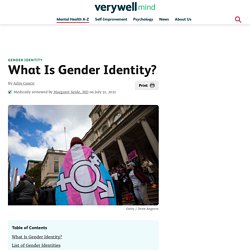
Although genetic factors usually define a person's biological sex, people determine their own gender identity. This article explores what gender identity is, definitions of various gender identities, and where individuals can find support. What Is Gender Identity? Because a person's sex and gender identity are separate, it's essential to know the difference between them. Range of Gender Identities. Gender Roles and Society. Children on Gender Roles. Gender Roles in Society. Beyond ‘He’ or ‘She’: The Changing Meaning of Gender and Sexuality. In Park City, Utah, students are lining up at a local high school to get their locker assignments for the semester.
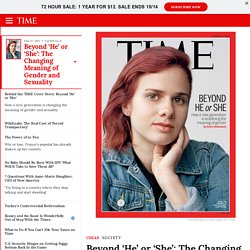
Extracurricular clubs have set up tables to attract new members. It’s only midday, but the Gay-Straight Alliance, a group with outposts at about a quarter of American secondary schools, already has 47 names on its sign-up sheet. Sitting behind piles of rainbow-colored paper cranes — a hot fundraising item — the group leaders are counting the different identity labels they’ve encountered. Sure, there’s lesbian, gay, bisexual, transgender. But there are more. Beyond Sex: A talk about gender identity in society. Albert Bandura. Summary: Social learning theory.
Albert Bandura's Social Learning Theory. Albert Bandura's Social Learning Theory By Saul McLeod, updated 2016 Social learning theory, proposed by Albert Bandura, emphasizes the importance of observing, modelling, and imitating the behaviors, attitudes, and emotional reactions of others.
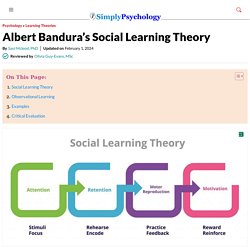
Social learning theory considers how both environmental and cognitive factors interact to influence human learning and behavior. In social learning theory, Albert Bandura (1977) agrees with the behaviorist learning theories of classical conditioning and operant conditioning. How Albert Bandura's Social Learning Theory Works.
Learning is a remarkably complex process that is influenced by a wide variety of factors. As most parents are probably very much aware, observation can play a critical role in determining how and what children learn.1 As the saying goes, kids are very much like sponges, soaking up the experiences they have each and every day. Because learning is so complex, there are many different psychological theories to explain how and why people learn. A psychologist named Albert Bandura proposed a social learning theory which suggests that observation and modeling play a primary role in this process.2. Observational Learning & The Social Learning Theory. How children learn about gender roles and identities? Gender roles and identity in children. It’s common for people to think of the terms ‘sex’ and ‘gender’ as being the same, but they mean different things.
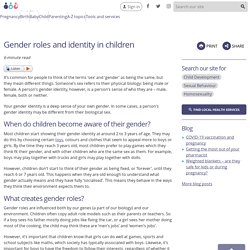
Someone’s sex refers to their physical biology: being male or female. A person’s gender identity, however, is a person’s sense of who they are – male, female, both or neither. Your gender identity is a deep sense of your own gender. In some cases, a person’s gender identity may be different from their biological sex. Children Learn Gender Roles. The social learning theory of sex differences: Imitation is alive and well. What media teach kids about gender can have lasting effects, report says. Story highlights Gender stereotypes are incredibly effective at teaching boys and girls what the culture expects Luckily, parents can assert control over the messages that Hollywood dishes out.
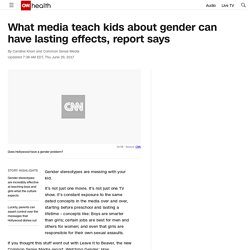
Gender representations in children's media and their influence. Gender identity. Gender identity refers to the deep and intimate feeling a person has of themselves.

Children begin to understand and express their gender identity early in life. This article discusses how gender identity typically develops and how parents and caregivers can promote healthy development of gender identity and expression in children. It's important to remember that each child is unique and may develop at a different pace. Why children are more likely to imitate and model certain behaviours? Children's Gender Roles & Stereotypes. This is what happens when gender roles are forced on kids. Story highlights A first-of-its-kind study looks at early adolescent gender identity development around the world Enforced gender expectations could lead to health inequities between boys and girls.
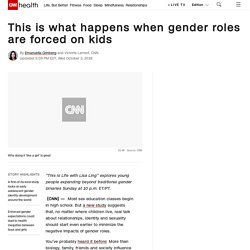
Harmful Gender Norms & Roles Can Create a Lifelong Cycle of Gender Inequality. All children deserve to grow up and achieve their dreams – regardless of their gender.

Tragically, inequitable gender norms rob millions of girls and boys of their childhoods – and risk their futures. Often, these damaging expectations directly contribute to the violation of children’s human rights. Gender norms describe how people of a particular gender and age are expected to behave in a given social context. Harmful gender norms result in many types of inequalities between girls and boys. However, while gender norms can affect all children, they are proven to disproportionately affect girls. Gender Stereotypes: Kids Believe Them By Age 10. Gender role on children. Summary: Harmful effects of gender roles and stereotypes.
5 ways parents can help kids avoid gender stereotypes. In the last century, significant progress has been made in advancing gender equity in the United States.
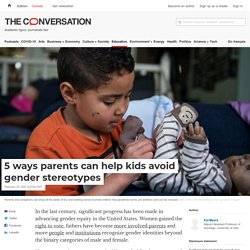
Women gained the right to vote, fathers have become more involved parents and more people and institutions recognize gender identities beyond the binary categories of male and female. However, persistent gaps remain. Children and gender identity: Supporting your child. Children and gender identity: Supporting your child Understand the importance of talking with your child about gender identity and expression — and how to get the conversation started.
By Mayo Clinic Staff If your child has questions about gender identity or gender expression, you've probably got questions, too. Find out what you can do to help and support your child. Kids' assumptions are turned around at career day in school. How parent influence kids' gender roles. Breaking traditional gender roles. How to avoid gender roles and stereotypes?